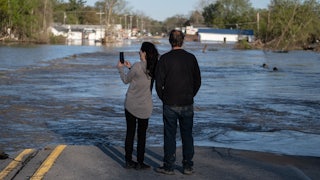In 2020, BP unveiled a plan to cut oil and gas production 40 percent by 2030 as part of the company’s goal to reach “net-zero” emissions by 2050 or sooner. This February, the company announced it’d instead seek a 25 percent reduction by the end of the decade. Then, on Monday, Reuters reported that BP intends to abandon that pledge altogether and instead expand production in the Middle East and the Gulf of Mexico.
BP wasn’t alone in making such a pledge in 2020, although its version was considered more ambitious than the plans put forward by its peers. Four years on, it’s joined the pack of oil and gas producers who’ve dramatically scaled back their more concrete net-zero plans. Shell, for instance, ditched its pledge to reduce oil and gas production by 2030 last year. The company then dropped its 2035 emissions-reduction pledge entirely this past March. Leading up to the U.N. climate talks in Glasgow in 2020, COP26—held just as the world started to emerge from Covid-19 lockdowns—governments and corporations alike fell over themselves to announce shiny new plans for reaching net-zero. Those promises have mostly fallen out of fashion among the politicians and executives who once championed them. So whatever happened to net-zero? What’s replaced it, and is the world any closer to getting there?
“Net-zero” was always a pretty vague slogan. In general, it implies reducing emissions of greenhouse gases. But there are some complications: The planet-heating effects of greenhouse gases are cumulative, meaning that we’ll be feeling the impact of carbon dioxide spewed decades ago for decades to come. Every additional ton of CO2 emitted now means more warming down the line. Limiting warming along the lines laid out in the Paris climate agreement, to “well below” two degrees Celsius (3.6 degrees Fahrenheit), is generally understood to mean stopping those emissions by 2050. In most scenarios scientists have modeled for reaching the Paris Agreement goals, though, limiting warming to two degrees or less also entails some amount of so-called “negative emissions” beyond that point. That will theoretically be accomplished by drawing greenhouse gases down from the atmosphere through direct air capture technologies or by creating additional carbon sinks, including via carbon offsets. That’s where the “net” of net-zero pledges comes in: An oil company that pledges to reach net-zero emissions by 2050, for example, might still plan to be emitting carbon by then but also plans at some point to capture all of the emissions it produces—or, audaciously, more—by deploying technologies to capture carbon.
Insofar as corporate pledges are concerned, though, net-zero has always tended to be more of a vibe. Fossil fuel producers, in particular, have fought to carefully define their emissions as being what they produce through their own operations—not the emissions produced by the products they sell, i.e., oil drilled, refined, and then burned in cars as gasoline. Companies’ net-zero plans and climate talking points also typically promise gargantuan amounts of negative emissions and rely heavily on dubious carbon-offset credits. When companies say they want to “achieve” net-zero, the idea is to signal that they care about climate change and that their business models are not only compatible with a net-zero world but an invaluable partner in arriving at one.
The proliferation of net-zero pledges a few years back came as governments responded to pressure from an upswell of climate activism around the world. That included movements targeting fossil fuel infrastructure directly—like Indigenous-led protests against the Keystone XL and Dakota Access pipelines—and groups like Fridays for Future and the Sunrise Movement, which rose to prominence in the United States pushing for a Green New Deal.
At the time, major fossil fuel producers were on the defensive for other reasons too, and looked weaker than they had in quite some time. Amid Covid-19 lockdowns, oil and gas demand plummeted as people drove and flew less. In the U.S., shale producers had spent a decade or so hemorrhaging investors’ cash to drill as much as they could as quickly as they could; companies highly specialized in shale production struggled to turn a profit. The pandemic-era crash in oil prices only made matters worse, making it even more difficult for smaller and midsize companies who specialized in high-cost unconventional production like fracking to break even. Bigger players were in trouble too. In 2020, ExxonMobil lost $22.4 billion—the first time it’d posted an annual loss since Exxon completed its merger with Mobil in 1999. In 2020, as well, ExxonMobil lost the place it’d held on the Dow Jones Industrial Average for 92 years. As they begged for bailouts, companies whose reputations were being dragged through the mud by climate activists needed to justify their choices not just to more climate-minded governments but to spurned investors, as well.
As Democratic primary candidates in the U.S. fell over themselves to promise billions for climate action, oil and gas companies in the U.S. and Europe seemed, similarly, to compete for their own climate bona fides, promising everything from production declines to robust investments in low-carbon technologies. Behind the scenes, rhetoric rarely matched reality. An October 2020 email exchange between Shell executives—unearthed as part of an investigation by the House Committee on Oversight and Reform—noted that the company’s net-zero talking points had “nothing to do” with the group’s business plans.
Soon enough, though, those companies’ fortunes changed. Global fuel demand came booming back as pandemic travel restrictions eased. Russia’s invasion of Ukraine—and ensuing Western-led sanctions on Russian oil and gas—fueled a surge of demand for U.S. fossil fuels in Europe. Companies were now earning record profits as they settled into a new business model. Executives now being hailed as patriotic defenders of democratic values pivoted away from the kinds of costly, rapid-fire production that defined the shale boom and focused on reducing debts, grinding out efficiencies, and delivering big payouts to shareholders. As profits soared, the same companies that had sent small armies to U.N. climate talks to boast about their net-zero plans began to quietly roll back those same pledges.
It wasn’t just executives who changed, though. Politicians on both sides of the Atlantic began to talk more about “energy security” than the energy transition, and encouraged a binge of spending on new fossil fuel infrastructure. The Biden administration urged oil and gas companies to drill more in a bid to lower gas prices, and went out of its way to backstop profits. After the Inflation Reduction Act became the law of the land—weakened considerably as a result of corporate lobbying—there was little chance of Congress passing a climate package that would credibly threaten its ability to drill, refine, and sell hydrocarbons for the foreseeable future. A judiciary branch stocked with right-wing appointees promised to stop federal regulations that might do the same in their tracks. The sorts of green industrial policy now in vogue in the U.S. and Europe, moreover—where most of the drillers now walking back their climate plans are based—are less concerned with reducing emissions than creating globally competitive green export sectors, defending legacy industries’ market share against competition from their geopolitical rivals.
In 2024, that is, the oil and gas industry simply has a lot less to worry about than it did in 2020—and a lot less reason to talk about net-zero.








